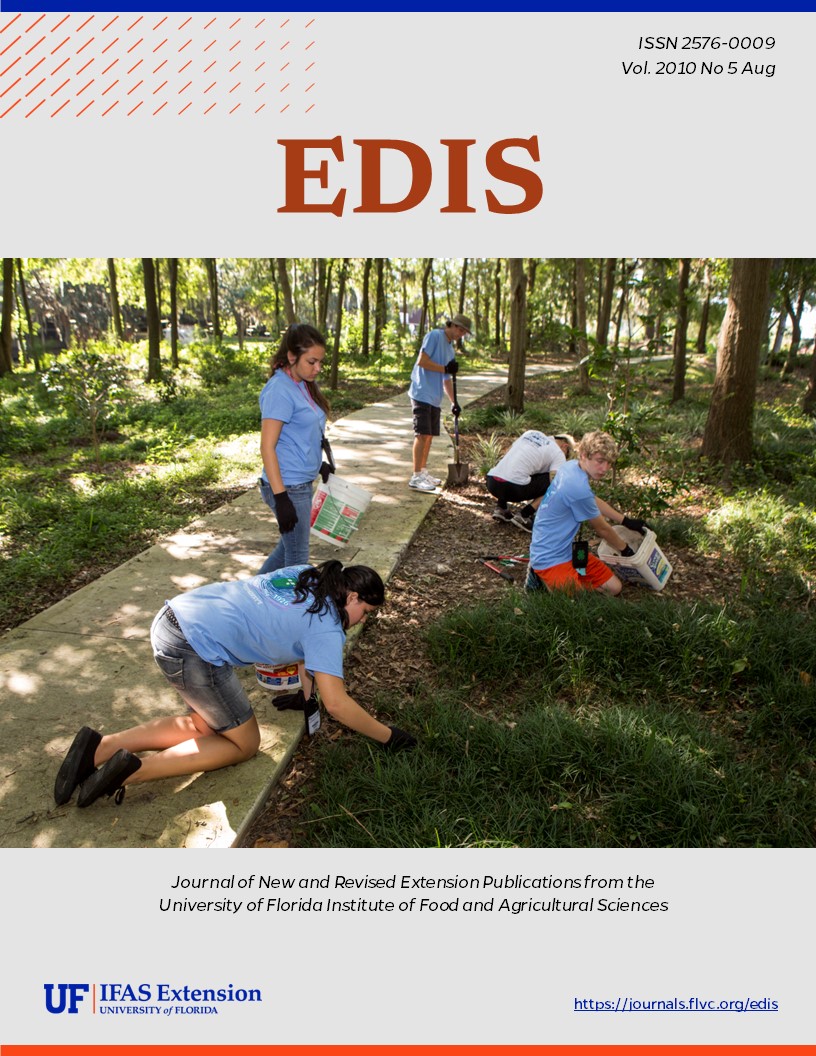Abstract
EENY 477, a 6-page illustrated fact sheet by Garima Kakkar, Daksina R. Seal, and Vivek Kumar Jha, is part of the Featured Creatures collection. It describes this relatively new vegetable pest in South Florida which is a key pest in tomato and cucumber fields in South America — synonymy, distribution, description, life cycle, hosts, economic importance, and management. Includes references. Published by the UF Department of Entomology and Nematology, July 2010.
References
Amin PW, Palmer JM. 1985. Identification of groundnut Thysanoptera. Tropical Pest Management 31: 268-291. https://doi.org/10.1080/09670878509371001
Arthurs S, McKenzie CL, Jianjun C, Dogramaci M, Brennan M, Houben K, Osborne L. 2009. Evaluation of Neoseiulus cucumeris and Amblyseius swirskii (Acari: Phytoseiidae) as biological control agents of chilli thrips, Scirtothrips dorsalis (Thysanoptera: Thripidae) on pepper. Biological Control 49: 91-96. https://doi.org/10.1016/j.biocontrol.2009.01.002
Best RJ. 1968. Tomato spotted wilt virus. Advances in Virus Research 13: 65-145. https://doi.org/10.1016/S0065-3527(08)60251-1
Cho JJ, Mau RFL, Hamasaki RT, Gonsalves D. 1988. Detection of tomato spotted wilt virus in individual thrips by enzyme-linked immunosorbent assay. Phytophathology 78: 1348-1352. https://doi.org/10.1094/Phyto-78-1348
Frantz G, Fasulo TR. (1997). THRIPS: A Knowledgebase of Vegetable Thrips. Glades Crop Care. http://www.gladescropcare.com/GCC_software.html (17 June 2010).
Hill DS. 1975. Agricultural Insect Pest of the Tropics and Their Control, Cambridge University Press, London.
Ishijima, T. (ed.). 2002. Manual de técnicas de cultivo de hortalizas de fruta (tomate, melón, frutilla. National Institute of Agriculture, Caacupé, Paraguay. 240 pp.
Milne JR, Jhumlekhasing M, Walter GH. 1996. Understanding host plant relationships of polyphagous flower thrips, a case study of Frankliniella schultzei (Trybom). In Goodwin S, Gillespie P. (eds), Proceedings of the 1995 Australia and New Zealand Thrips Workshop: Methods, Biology, Ecology and Management, NSW Agriculture, Gosford. 8-14.
Monteiro RC, Mound LA and Zucchi RA. 2001. Espécies de Frankliniella (Thysanoptera: Thripidae) de importância agrícola no Brasil. Neotropical Entomology 1: 65-71. https://doi.org/10.1590/S1519-566X2001000100011
Mound LA. 1968. A review of R.S. Bagnall's Thysanoptera collections. Bulletin of the British Museum (Natural History) Entomology. Supplement. 11: 1-181. https://doi.org/10.5962/p.78614
Mound LA. 2004. Australian Thysanoptera - biological diversity and a diversity of studies. Australian Journal of Entomology 43: 248-257. https://doi.org/10.1111/j.1326-6756.2004.00431.x
Nagata T, De Avila AC. 2000. Transmission of chrysanthemum stem necrosis virus, a recently discovered tospovirus, by thrips species. Journal of Phytopathology 148: 123-125. https://doi.org/10.1046/j.1439-0434.2000.00475.x
Nakahara S. 1997. Annotated list of the Frankliniella species of the world (Thysanoptera: Thripidae). Contributions on Entomology, International 2: 355-389.
Palmer JM. 1990. Identification of the common thrips of tropical Africa (Thysanoptera: Insecta). Tropical Pest Management 36: 27-49. https://doi.org/10.1080/09670879009371431
Prins M, Goldbach R. 1998. The emerging problem of tospovirus infection and nonconventional methods of control. Trends in Microbiology 6: 31-35. https://doi.org/10.1016/S0966-842X(97)01173-6
Sakimura K. 1969. A comment on the color forms of Frankliniella schultzei (Thysanoptera: Thripidae) in relation to transmission of the tomato-spotted wilt virus. Pacafic Insects 11: 761-762.
Vierbergen G, Mantel WP. 1991. Contribution to the knowledge of Frankliniella schultzei (Thysanoptera: Thripidae). Entomologische Berichten (Amsterdam) 51: 7-12.
Wijkamp I, Almarza N, Goldback R, Peters D. 1995. Distinct levels of specificity in thrips transmission of tospoviruses. Phytopathology 85: 1069-1074. https://doi.org/10.1094/Phyto-85-1069
Yaku A, Walter GH, Najar-Rodriguez AJ. 2007. Thrips see red - flower colour and the host relationships of a polyphagous anthophilic thrips. Ecological Entomology 32: 527-535. https://doi.org/10.1111/j.1365-2311.2007.00899.x

